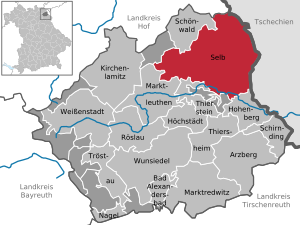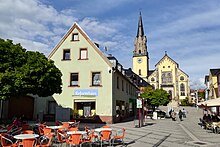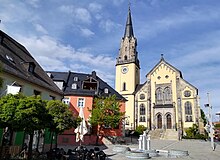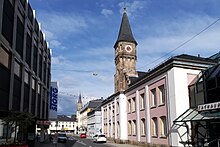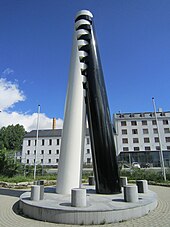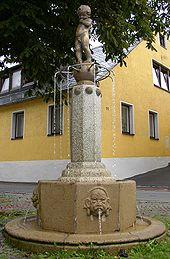Same
| coat of arms | Germany map | |
|---|---|---|

|
Coordinates: 50 ° 10 ′ N , 12 ° 8 ′ E |
|
| Basic data | ||
| State : | Bavaria | |
| Administrative region : | Upper Franconia | |
| County : | Wunsiedel in the Fichtel Mountains | |
| Height : | 562 m above sea level NHN | |
| Area : | 86.06 km 2 | |
| Residents: | 14,895 (Dec. 31, 2019) | |
| Population density : | 173 inhabitants per km 2 | |
| Postal code : | 95100 | |
| Area code : | 09287 | |
| License plate : | WUN, MAK, REH , SEL | |
| Community key : | 09 4 79 152 | |
| LOCODE : | DE SEB | |
| City structure: | 45 districts | |
City administration address : |
Ludwigstrasse 6 95100 Selb |
|
| Website : | ||
| Lord Mayor : | Ulrich Pötzsch (Active Citizens) | |
| Location of the city of Selb in the district of Wunsiedel in the Fichtel Mountains | ||
Selb is a large district town in the district of Wunsiedel in the Fichtelgebirge ( administrative district of Upper Franconia ) and is located directly on the Czech border. It belongs to the cross-border microregion Friends in the heart of Europe . Selb is known nationwide as a porcelain town and is located on the Bavarian Porcelain Route . In the country's development program Bayern Selb, together with the Czech neighbor town of Aš as a regional center reported.
geography
Geographical location
The city is located in northeast Bavaria relatively close to Saxony (approx. 20 km away) and Thuringia (approx. 30 km away). Selb is located in the upper entrance area of the horseshoe-shaped Fichtelgebirge, which is open to the northeast; nearby mountains are the Kornberg in the west, the Wartberg and the Hengstberg in the east. The Selb flows through the urban area . The Czech Republic is directly adjacent; a border crossing to the neighboring town of Aš is located north between the districts of Lauterbach and Wildenau.
City structure
The city of Selb is divided into 45 districts:
In the north of Selb there are Vielitz, Green Fleck, Vielitz-Siedlung, Selb-Plößberg and Plößberg, Erkersreuth and Lauterbach. To the west are Ober-, Mittel- and Unterweißbach, a little further on Steinselb, Spielberg and Heidelheim. To the east of Selb are Wildenau, Schatzbach, Mühlbach, Längenau and Buchwald. Silberbach is to the south.
Neighboring places
To the northeast, Schönwald borders directly on Selb. A little more than 10 km to the south-west are Kirchenlamitz and Marktleuthen ; in the south are Höchstädt in the Fichtelgebirge and Thiersheim and in the southeast Hohenberg an der Eger . Hazlov (in the east) and Aš (in the northeast) lie behind the state border with the Czech Republic .
history
Until the 19th century
Colonization in the 12th century brought settlers from the Bavarian region to the region around Selb. A noble family called "de Selewen" has been documented since 1135. Selb was first mentioned in a document in 1281, when it was pledged by Emperor Friedrich II. Together with the neighboring Aš (Asch) in today's Czech Republic to the field captain Vogt Heinrich von Plauen and the Roman-German King Rudolf von Habsburg had a certificate issued about it. In 1357 Selb was transferred to the Forster family as an imperial fief, because it was from there that the Eger imperial forest was administered. In 1412 Selb was sold to the burgraves of Nuremberg. In 1437 they created the Sechsämterland , so called because the administrative tasks were decentrally distributed over six official cities . One of these six offices was Selb. In 1426, Margrave Friedrich I of Bayreuth-Brandenburg granted the city its first town charter (the so-called Wunsiedler town charter ). It remained the center of the margraves' forest and preferred hunting ground for the Bayreuth princes. The deer antlers in the city coat of arms are a reminder of the city's importance in hunting history. In Selb, there was a medieval leprosarium "in front of the Erkersreuther Tor" in the 16th century , it was called "Siechhaus".
After several changes of ownership and war destruction in the following centuries, Selb gained importance as a mining site in connection with hammer and iron smelting works well into the 18th century. The most important hammer mills (Wenden-, Kaiser-, Schwarzen- and Hendelhammer) used the water power of the Eger . Mining was carried out in the quarry on the Häusellohe (today's Schausteinbruch). The very fine-grain granite deposit there, which does not contain any iron, was mainly used in the second half of the 19th century to manufacture technical rollers for the porcelain industry and millstones.
In the 18th century, Selb was a craft town with around 1500 inhabitants and guilds of joiners, carpenters, tanners, millers, shoemakers and weavers. In 1709 the papermaker Johann Georg Jäger built a paper mill. It was the first industrial company in the city, which was important for the printing industry until the 1970s.
After the peace treaty of Vienna in 1809, Selb became Bavarian on June 30, 1810. On June 17, 1836, it was promoted to city. Due to the carelessness of a maid, the building near the old pharmacy caught fire on March 18, 1856. The rapidly spreading fire, known as "Self Fire", destroyed the city and with it the medieval city center . Only a few buildings survived the firestorm unscathed, including the Gottesackerkirche for the Holy Trinity from 1612 and the so-called Pechhütte from around 1583, a small, secular half-timbered building in which the Pechsiederhandwerk was carried out; these two buildings were outside the city center. A total of 221 houses and 408 outbuildings were reduced to rubble, and 624 families (over 3500 people) were made homeless.
Around 1857 Selb developed into a porcelain town. Some of the weavers, who had become unemployed as a result of the fire themselves, found work again when Lorenz Hutschenreuther set up the first porcelain factory on Ludwigsmühle in 1857. His pioneering act was that he enabled the industrial series production of porcelain. The "white gold" became affordable for ordinary people.
The connection in 1864 to the Hof – Eger railway facilitated the rapid industrial development in Selb. The porcelain factories Jakob Zeidler & Co., J. Rieber, Rosenthal, Krautheim, Müller, Heinrich & Co., Jäger & Werner, Gräf & Krippner, Krautheim & Adelberg, Zeidler & Purucker, Gebr. Hofmann and the Upper Franconian porcelain factory were founded. In 1900 Selb already had 7200 inhabitants. There were 20 porcelain factories with a total of 100 round ovens.
20th century
On July 1, 1919, Selb was spun off from the Rehau district and declared an independent city. In 1930 the city had grown to 14,200 inhabitants. However, the number of porcelain factories had declined in the wake of the Great Depression and inflation of the 1920s. Most factories were through mergers have been transferred to other companies. The remaining ones developed into global brands. The world-famous brands Rosenthal and Hutschenreuther are still based in Selb today .
At the end of World War II, Selb was captured by American troops. 3,500 refugees from eastern Germany came to the city. Due to the new demarcation, Czechoslovakia and Saxony were no longer used as markets and sources of raw materials for the porcelain industry.
In the course of administrative reform Selb was on 1 July 1972 as a large district the district Wunsiedel assigned.
In the 1990s the tableware and luxury tableware sectors experienced a crisis. The number of jobs in the porcelain companies fell from 5,000 in 1965 to less than 1,000. Technization, rationalization and the relocation of production abroad in order to save costs ushered in a radical structural change in the city and the region. Today, numerous other industries shape the economic structure in Selb. In addition to the ceramics industry, machine and plant engineering, the automotive supply industry and plastics processing have established themselves at this industrial location.
Incorporations
On January 1, 1978, the communities of Erkersreuth, Heidelheim, Längenau , Mühlbach, Oberweißbach, Selb-Plößberg (until July 5, 1953, Plößberg bei Selb), Silberbach, Spielberg and Unterweissenbach as well as parts of the dissolved communities Lauterbach and Vielitz were incorporated. On August 1, 2013, the community-free area of Selber Forst and part of the community-free area of Hohenberger Forst were incorporated.
Population development
Between 1988 and 2019 the population decreased from 19,275 to 14,981 by 4,294 inhabitants.
The number of inhabitants developed as follows:
| date | Residents |
|---|---|
| December 1, 1840 | 6.141 |
| December 1, 1871 | 7,405 |
| December 1, 1900 | 10,766 |
| June 16, 1925 | 17,554 |
| May 17, 1939 | 17,637 |
| September 13, 1950 | 24,336 |
| June 6, 1961 | 24,532 |
| May 27, 1970 | 24,039 |
| May 25, 1987 | 19,615 |
| December 31, 1991 | 19,771 |
| December 31, 1995 | 19,533 |
| December 31, 2001 | 17,870 |
| June 30, 2005 | 17,156 |
| December 31, 2010 | 15,894 |
| May 9, 2011 | 15,425 |
| December 31, 2015 | 14,928 |
| November 8, 2017 | 16,500 |
| October 18, 2018 | 16,590 |
| September 30, 2019 | 14,981 |
politics
Mayor (since 1912)
- 1912–1920: Heinrich Marquart
- 1920–1929: Viktor Häublein
- 1930–1934: Kurt Schröter
- 1934–1945: Fritz Eichinger (NSDAP)
- 1945–1948: Hans Feßl
- 1948–1956: Franz Bogner (SPD)
- 1956–1988: Christian Höfer (SPD)
- 1988–2001: Werner Schürer (SPD)
- 2001-2013: Wolfgang Kreil (CSU / Free Voters)
- since 2013: Ulrich Pötzsch (active citizens)
City council
The last local elections resulted in the following allocation of seats in the city council :
| Party / list | 2002 | 2008 | 2014 | 2020 |
|---|---|---|---|---|
| CSU / Free Voters Selb | 11 | 12 | 9 | - |
| Active citizens | 5 | 6th | 8th | 9 |
| SPD | 8th | 6th | 7th | 5 |
| CSU | - | - | - | 6th |
| Free voters Selb | - | - | - | 3 |
| Alliance 90 / The Greens | - | - | - | 1 |
| total | 24 | 24 | 24 | 24 |
coat of arms
Description of coat of arms : “Split; front quartered with blue and silver; at the back divided by blue and red, each with a silver deer antler. "
Significance: Selb came to the Burgraves of Nuremberg in 1412, who granted the market town rights in 1426. Imprints of a seal have come down to us from 1430, which was probably created in connection with the city elevation. The picture shows the zolleric crossing of silver and black at the front, two deer antlers one above the other at the back. Selb was the center of the margravial forest and hunting ground for the princes as well as the seat of an office in the Sechsämterland. In a colored illustration from 1581 the rear half of the shield appears in silver, the deer antlers are black-brown. The division of the rear half of the shield appears for the first time in an illustration from 1767. In a municipal report from 1812, the Zollernvierung shows the colors gold and silver, the fields in the rear half of the shield are blue and red. The Zollernvierung has been in the Bavarian state colors of silver and blue since 1819 and has remained so to this day. Since 1819 the antlers have been silver instead of gold. Hupp gives the coat of arms in its historically correct tinging.
Town twinning
Selb maintains city partnerships with the French Beaucouzé , the Czech Pardubice (German Pardubitz ) and the Japanese Mizunami .
Culture and sights
theatre
The cultural center of the city is the Rosenthal Theater. It is located in the middle of Selb on the slope of the Selbbach valley . The spectrum of the cultural program extends from operas, operettas and musicals to theatrical performances; In addition, symphony concerts alternate with chamber concerts, jazz concerts, cabaret events and performances by local stage associations as well as by the singing, social and music associations. Particular attention is paid to what is on offer in the area of children's and youth theater.
Museums
- Porzellanikon Selb
- Porzellanikon , an anchor point on the European Route of Industrial Culture (ERIH), is the name of an entire museum complex in the historic Selb-Plößberg porcelain factory. The visitor can find out about the history of porcelain production over the past three centuries, supported by demonstrations at the workplaces, large video projections and other media. Finished products can be seen in the Rosenthal Museum, which is also located there. 125 years of company history are presented in design and art. A separate exhibition area has been dedicated to technical ceramics since 2005. The conclusion in 2014 was the new presentation on the social history of porcelain makers. The complex in Selb-Plößberg , together with the location in Hohenberg an der Eger, is the largest special museum for porcelain in Europe.
- Historical showcase break in the Häuselloh
- All equipment and machines are largely in their original condition and ready for operation. Guided tours usually take place between April and October.
- Historic engine shed
- Stock (2008): 25 original vehicles. These include a steam locomotive, an electric locomotive, five standard gauge diesel locomotives, two narrow-gauge diesel locomotives, two motor draisines , a baggage car, a passenger car and twelve freight cars. Visits every Saturday between 12:00 p.m. and 4:00 p.m.
Buildings
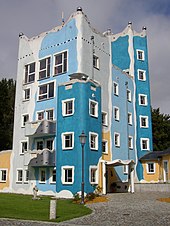
- Porcelain fountain on Martin-Luther-Platz
- Porcelain fountain redesigned in 2003 by the porcelain manufacturer Barbara Flügel, which is a striking focal point in fresh blue and turquoise tones and underlines its noble effect with white and gold. Over 45,000 porcelain plates were used.
- City Church of St. Andrew
- The town church of St. Andreas was built on the site of the old town church after the devastating fire in 1856, but not on its foundation. What is remarkable about the church, which was built in neo-Gothic style, is the organ with its total of 2,711 organ pipes , 554 of which are still original pipes from Heinrich Keller's workshop, and the baroque lecture crosses from the 18th century.
- Porcelain glasses
- A unique landmark of the city is the Porzellangässchen: 55,000 colored porcelain tiles were put together as a mosaic. The advertising slogan is: "Here you really walk on an expensive pavement."
- Fountain of life on the Gerberplatz
- The fountain of life on Gerberplatz, created by the well-known sculptor Wolfgang Stefan himself, symbolizes the cycle of life by vividly depicting the development of man from child to old man.
- City history on porcelain at the Welzel House
- One of the greatest works of art made of porcelain in Selb is the history of the town on porcelain at the Welzel-Haus. The porcelain wall donated by Hutschenreuther AG in 1988 for the 125th anniversary of the company shows the significant stages in the history of the city, starting with the first documentary mention of the city in 1281. After the Selber fire in 1856, the reconstruction began until the first porcelain factory was built in 1857 by Lorenz Hutschenreuther. The coats of arms of the aristocratic houses under whose rule Selb was in the course of its development can also be seen on the porcelain wall, as well as the Selber city coat of arms .
- Glockenspiel and city arms made of porcelain
- The porcelain carillon made of Meissen porcelain at the Selber town hall consists of 22 bells and was designed in 1994 by the State College for Ceramics. Depending on the season, different melodies sound at 11 a.m., 1 p.m., 3 p.m. and 5 p.m. due to the sound sources on both sides next to the town hall balcony with a stereo effect .
- Buberl fountain
- In addition to the ubiquitous porcelain, it is the symbol of the city of Selb. It has existed since 1921, a time when nobody thought of furnishing the industrial city of Selb with works of art.
- Factory facades of Rosenthal AG
- Designed by Otto Piene , Friedensreich Hundertwasser and Marcello Morandini in Wittelsbacherstraße, the Rothbühl plant by Professor Walter Gropius .
- Porcelain fountain at the Sparkasse
- The fountain was designed by Hans Achtziger and Erich Höfer.
- Gottesackerkirche for the Holy Trinity
- Built in 1612
- Bad luck
- Small secular half-timbered building, in which the pitch boiler trade was carried out (from around 1583).
- Erkersreuth Castle
- Built in 1748 in the Rococo style by Johann Christian August von Lindensfels.
freetime and sports
- The city is located at the foot of the Fichtelgebirge and offers many opportunities for leisure activities, such as skiing in winter on the Wartberg or the Kornberg or visiting the forest pool "Langer Teich" in summer. In the city there is the Hutschenreuther ice rink, the Rosenthal theater and the indoor swimming pool. The best-known Selber sports club is the VER Selb ice hockey club .
- The Park of Remembrance is a green area in the historic city center with exhibits from the Cold War era and German reunification .
Regular events
- Art night yourself
- The Art Night has been held annually in March since 2001. Numerous companies, organizations and institutions from Selb present art, culture and culinary delights throughout the entire city.
- International Frontier Film Days
- The international film festival, which takes place every year in the week after Easter, was founded in Wunsiedel in 1977; since 1981 the venue has been the cinema center in Selb. It is one of the oldest film festivals in Germany and the oldest German film festival with an Eastern European focus.
- Citizen Festival
- The citizens' festival always takes place on the first Saturday in June. Associations and associations themselves present themselves throughout the city center. There is also a flea market.
- Meilerfest
- Every year in the week of Corpus Christi the Meilerfest takes place on the Häusellohe.
- Homeland and meadow festival
- The Selber Heimat- und Wiesenfest takes place every year on the second weekend in July on the Goldberg. The origins of this homeland and children's festival go back to 1807.
- Weeks of the White Gold
- July August
- Festival of porcelain makers
- Since 1989 the Porzellinerfest has been celebrated annually on the first Saturday in August with Europe's largest porcelain flea market.
- Europe's largest medieval festival has been held in Selb every September since 2008.
Economy and Infrastructure
Selb is the center of the porcelain industry in Germany, which arose there from 1856 onwards due to small kaolin deposits that were already exhausted by 1900 . The companies Hutschenreuther, Rosenthal and BHS Tabletop produce almost half of the German production. In addition, there are mechanical and plant engineering, technical ceramics, electrical engineering and plastics processing companies in the city.
Established businesses
- ACTIVA grill kitchen GmbH
- HM Heiße Metallwaren GmbH
- Rosenthal GmbH with Hutschenreuther (porcelain)
- BHS tabletop AG (porcelain)
- Linseis Messgeräte GmbH (device construction, measurement data acquisition)
- Vishay Europe GmbH (technology)
- Netzsch Group (mechanical engineering, apparatus and device construction)
- Rapa - Rausch & Pausch GmbH (automotive supplier)
- TRW Automotive Inc. (automotive supplier)
- Kyocera Fineceramics Precision GmbH (ceramics)
- Playmobil (plastic)
- Textile finishing Drechsel (coating and dyeing)
- andré Andres GmbH (advertising)
- Bohemia Cristal Handelsg.mbH (glass / porcelain)
- Andritz Separation GmbH (filtration technology)
- Grießhammer tool and mold construction (metal processing)
- Dressel GmbH (plastics processing)
- BKW Kunststoff GmbH
- Energieversorgung Selb-Marktredwitz GmbH (energy supplier)
- ML-INFRASYSTEME GmbH (special service provider road and airport construction)
- Kirschneck GmbH Folienfabrik (film manufacturer)
- SI-KA-TEC GmbH engineering coating (silicone coating of technical textiles)
- BVS Busverkehr Selb
education
- Elementary school Selb I + II, secondary school and elementary school
- Elementary School Selb III (Luitpold School)
- Elementary school Erkersreuth elementary school
- State secondary school Selb
- State Walter-Gropius-Gymnasium Selb
- Private school to promote learning Selb
- State vocational school center for product design and testing technology Selb
- State technical college for product design
- State vocational college for product design
- State technical college for materials and testing technology
- State vocational school Selb
- Professional training center Hof (bfz GmbH)
- Vocational school for nursing assistants
- Training yard of the Chamber of Crafts
- Music school Selb
- Adult Education Center Selb
- City library Selb
Station of the earthquake service in Bavaria
In the district of Vielitz, during an earthquake swarm in 1985/86, one of the oldest stations of the Bavaria earthquake service was built in the northeast of the Free State. Since then, it has provided a lot of important data for scientific studies. The station is housed in a former elevated water tank above the town of Selb near the Czech border.
Station data in detail:
- Altitude: 670 m above sea level
- Geographical location: 12.103 degrees east longitude and 50.186 degrees north latitude
- Seismometer: Lennartz Le3D-1 Hz 3 components
- Digitizer: Lennartz M24 (sampling rate 200 Hz)
Public facilities
- Selb is the location of a federal police station , which received a new building from the end of 2012 to summer 2014.
- The former police station of the Bavarian Police was downgraded to a guard.
Personalities
Honorary citizen
- Lorenz Hutschenreuther (December 25, 1885)
- Viktor Hutschenreuther (October 10, 1900)
- Wilhelm Baumann (July 12, 1907)
- Philipp Rosenthal (February 15, 1918)
- Christian Povenz (February 9, 1927)
- Franz Bogner (January 1, 1946)
- Carl Wilhelm Netzsch
- Philip Rosenthal M. A. (July 4, 1989)
- Roland Dorschner
- Jürgen Warnke (1932–2013) Federal Minister a. D.
sons and daughters of the town
- Georg Riedel (1900–1980), politician (CSU, FDP)
- Helmut Drexler (1927–2016), porcelain painter and designer
- Horst Meyer-Selb (1933–2004), musician, pianist, composer and music teacher
- Herbert Güthlein (1935–2018), politician
- Helmut Baumgärtel (* 1936), chemist
- Jürgen G. Heinrich (* 1949), ceramic engineer
- Richard Rogler (* 1949), cabaret artist
- Gerhard Schmid (* 1952), entrepreneur and founder of mobilcom
- Siegfried Hausner (1952–1975), member of the RAF
- Kalle Schwensen (* 1953), Hamburg red light star and entrepreneur
- Peter Schiller (1957–2020), ice hockey player
- Manfred Ahne (* 1961), ice hockey player
- Anja Tuckermann (* 1961), author and journalist
- Jörg Hanft (* 1964), ice hockey player
- Udo Döhler (* 1968), ice hockey player
- Andreas Strobel (* 1972), ski mountaineer and cyclist
- Florian Ondruschka (* 1987), ice hockey player
- Sebastian Bösel (* 1994), soccer player
People who work or have worked in Selb
- Ewald Jarmer (* 1942), amateur boxer
- Frank Hördler (* 1985), ice hockey player
literature
- Michael Brix , Karl-Ludwig Lippert : Former district of Rehau and town of Selb (= Bavarian art monuments . Volume 34 ). Deutscher Kunstverlag, Munich 1974, ISBN 3-422-00545-5 , p. 78-91 .
- Johann Kaspar Bundschuh : Selb . In: Geographical Statistical-Topographical Lexicon of Franconia . tape 5 : S-U . Verlag der Stettinische Buchhandlung, Ulm 1802, DNB 790364328 , OCLC 833753112 , Sp. 282-283 ( digitized version ).
- Georg Paul Hönn : Same . In: Lexicon Topographicum of the Franconian Craises . Johann Georg Lochner, Frankfurt and Leipzig 1747, p. 293 ( digitized version ).
- Pleikard Joseph Stumpf : Selb . In: Bavaria: a geographical-statistical-historical handbook of the kingdom; for the Bavarian people . Second part. Munich 1853, p. 633-634 ( digitized version ).
Web links
- Internet presence of the city of Selb
- Entry on the coat of arms of Selb in the database of the House of Bavarian History
Individual evidence
- ↑ "Data 2" sheet, Statistical Report A1200C 202041 Population of the municipalities, districts and administrative districts 1st quarter 2020 (population based on the 2011 census) ( help ).
- ^ City of Selb in the local database of the Bavarian State Library Online . Bayerische Staatsbibliothek, accessed on January 5, 2018.
- ↑ Overview of the districts on the official website of Selb
- ↑ Documentation: Medieval Leprosories in Today's Bavaria, originally in Die Klapper 1995, Journal of the Society for Leprosy, accessed January 14, 2018 ( Memento of the original from February 6, 2015 in the Internet Archive ) Info: The archive link was inserted automatically and has not yet been checked . Please check the original and archive link according to the instructions and then remove this notice.
- ^ Wilhelm Volkert (ed.): Handbook of Bavarian offices, communities and courts 1799–1980 . C. H. Beck'sche Verlagsbuchhandlung, Munich 1983, ISBN 3-406-09669-7 , p. 556 .
- ^ Federal Statistical Office (ed.): Historical municipality directory for the Federal Republic of Germany. Name, border and key number changes in municipalities, counties and administrative districts from May 27, 1970 to December 31, 1982 . W. Kohlhammer, Stuttgart / Mainz 1983, ISBN 3-17-003263-1 , p. 700 .
- ↑ Upper Franconian Official Gazette from August 2013 ( Memento of the original from March 4, 2016 in the Internet Archive ) Info: The archive link was inserted automatically and has not yet been checked. Please check the original and archive link according to the instructions and then remove this notice. (PDF)
- ↑ Statistics Bavaria, p. 6 (accessed on March 16, 2013; PDF; 1.3 MB)
- ↑ frankenpost.de: 750 new jobs for 16,590 residents
- ↑ Population of the municipalities, districts and administrative districts 3rd quarter of 2019. September 30, 2019, accessed on May 17, 2020 .
- ↑ a b HdBG : Large district town Selb
- ↑ DeLeA e. V. - German-Japanese town twinning. (No longer available online.) Archived from the original on May 21, 2016 ; accessed on September 27, 2017 . Info: The archive link was inserted automatically and has not yet been checked. Please check the original and archive link according to the instructions and then remove this notice.
- ↑ Christoph Schmälzle: The Porzellanikon. From the shop window of industry to the Bavarian State Museum . In: Wilhelm Siemen (Hrsg.): Writings and catalogs of the Porzellanikons - State Museum for Porcelain Hohenberg ad Eger / Selb . tape 129 . Porzellanikon - State Museum for Porcelain Hohenberg ad Eger / Selb, Selb 2019, ISBN 978-3-940027-37-5 .
- ↑ HC Starck - Japanese Kyocera takes over HC Starck Ceramics. Retrieved November 2, 2019 .
- ↑ www.frankenpost.de: Playmobil takes over the company in Selb
- ↑ Federal police returns to Selb , General-Anzeiger , December 17, 2012

